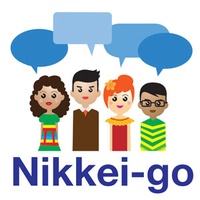Nikkei Chronicles #5—Nikkei-go: The Language of Family, Community, and Culture

Arigato, baka, sushi, benjo, and shoyu—how often have you used these words? In an informal survey conducted in 2010, we found that these were the most frequently used Japanese words among Japanese Americans living in Southern California.
In Nikkei communities around the world, the Japanese language symbolizes the culture of one’s ancestors, or the culture that was left behind. Japanese words often get mixed in with the language of the adopted country, creating a fluid, hybrid way of communicating.
For this series, we asked our Nima-kai community to vote for their favorite stories and an editorial committee to pick their favorites. In total, five favorite stories were selected.
Here are the selected favorite stories.
Editorial Committee’s Selections:
- ENGLISH:
Yokoso Y’all
By Linda Cooper
- JAPANESE:
Brazil is My Second Home — Japan is My Spiritual Home
By Marina Tsustui
- SPANISH:
The Chuo Gakuen School: The Seeds of Prestige for the Japanese Community in Mexico
By Sergio Hernández Galindo
- PORTUGUESE:
Gaijin
By Heriete Setsuko Shimabukuro Takeda
Nima-kai selection:
- 56 stars:
The Japanese language in the daily lives of the members of the Hikari Group of Londrina
By Alba Shioco Hino, Nilza Matiko Iwakura Okano, Kiyomi Nakanishi Yamada
Stories from this series
To my three children: A father's experience of living in a multilingual world
Oct. 13, 2016 • Toshiro Obara
To the three children Hello how are you? You three were born in America and live a multilingual life, speaking English outside the home and Japanese at home. Since you started attending local schools, you have become very good at English, and I want you to think that speaking in English is easy, but I don't want you to think that speaking, listening, writing, reading, and thinking in Japanese is a hassle. Your father also lived in Mexico as a …
Nikkei with Y
Oct. 11, 2016 • Claudio Sampei
108 years after the Kasato Maru ship officially brought the first immigrants from Japan, Brazil is proud to be the country with the largest number of Nikkei in the world. With this information alone, perhaps an uninformed person might believe that due to the large number of Nikkei , Brazil is accustomed to the Japanese language, just as it is currently accustomed to eating sushi and watching anime . I'm mistaken... Even in São Paulo, where the majority of Nikkei …
Gaijin
Oct. 6, 2016 • Heriete Setsuko Shimabukuro Takeda
I couldn’t understand my friend Emília. I brought her along to spend the holidays at my grandmother's house in Santos, hoping she would put to use her knowledge of the Japanese language, since I had almost none. Or rather, none at all. But after a few minutes of conversation, she calls me aside and confesses: I can’t understand what your grandmother says! - What do you mean? You told me you could speak Japanese! - I know, but I can’t …
Daikon, Kabu, Akadaikon, Akakabu
Oct. 3, 2016 • Nilton Suenaga
After starting to cook in a slightly more conscious manner (living with Bia, my girlfriend, I’ve naturally left behind those university days when I thought that adding garlic to the Fugini tomato sauce was a great culinary feat), I began shopping weekly at the street market in my area, thinking a little about my physical health and a lot about my financial health. Born and raised in a typical Japanese–Brazilian family in the interior of São Paulo, for a long …
Dona Terezinha’s teachings
Sept. 27, 2016 • Silvia Lumy Akioka
My mother's name was Terezinha. She left us this earthly life at the age of 59 and I consider that she lived very little. They say that good people live a short life because they needed less time to evolve spiritually. I believe this, my mother was a great person. I have many memories with her and as we are a Nikkei family, some of these memories refer to striking Japanese words. We are three daughters. That's right, only women. …
The Japanese language in the daily lives of the members of the Hikari Group of Londrina
Sept. 19, 2016 • Alba Shioco Hino , Nilza Matiko Iwakura Okano , Kiyomi Nakanishi Yamada
We belong to a generation of children, youths, adults, and seniors who are descendants of Japanese immigrants who came to Brazil in the years before World War II. Some are children, others are grandchildren, great-grandchildren, and great-great-grandchildren of these immigrants. After leaving Japan, our ancestors gradually began to absorb Western culture, although the influence of Japanese culture has been preserved in many families, especially when the younger generations come in contact with older people who pass on to the younger …






























